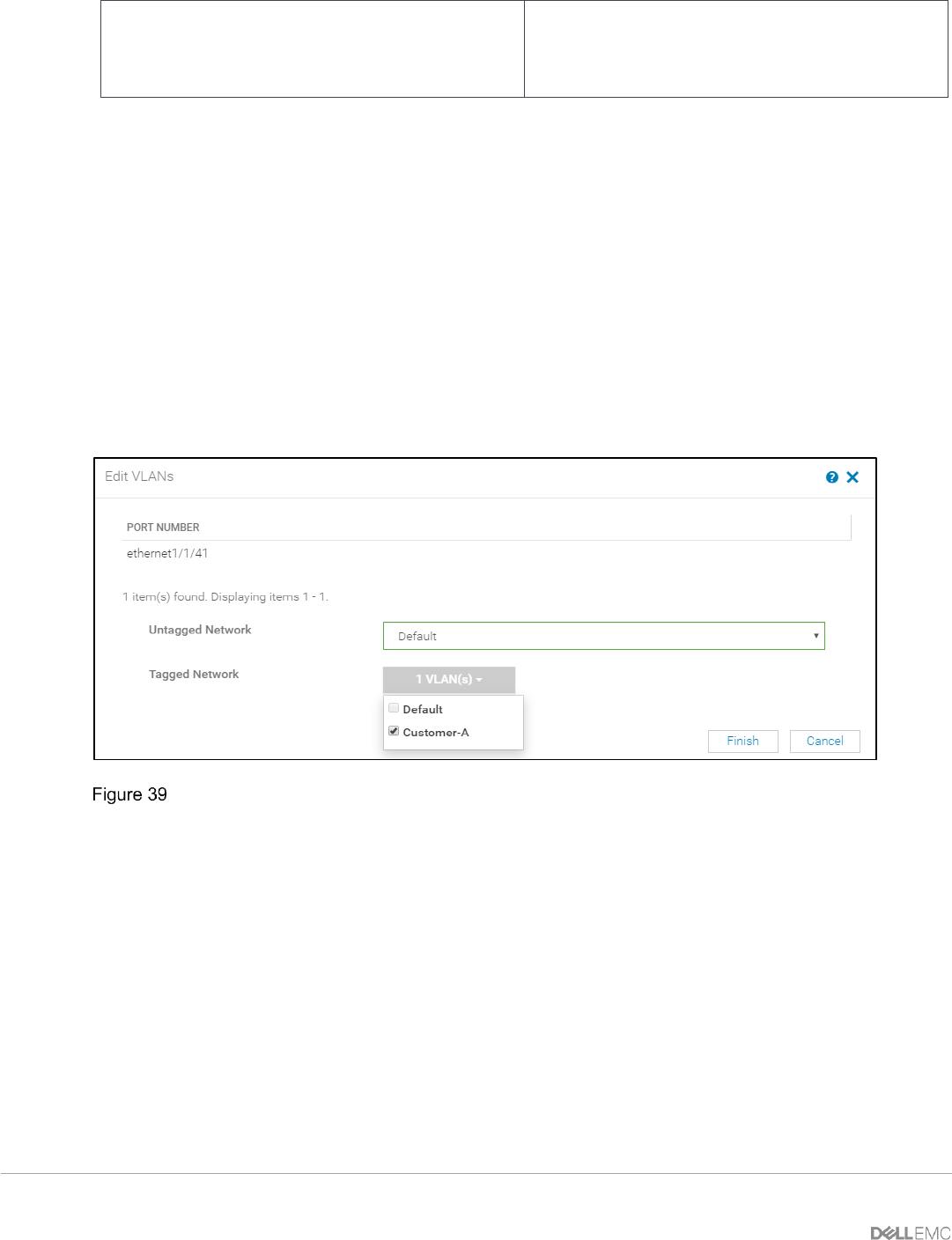Users Guide
Table Of Contents
- 1 Introduction
- 2 SmartFabric Services for PowerEdge MX: An overview
- 3 SmartFabric mode requirements, guidelines, and restrictions
- 3.1 Create multi-chassis management group
- 3.2 Upstream network requirements
- 3.3 VLAN scaling guidelines
- 3.4 Configuring port speed and breakout
- 3.5 Switch slot placement for SmartFabric mode
- 3.6 Switch-to-Switch cabling
- 3.7 NIC teaming guidelines
- 3.8 Maximum Transmission Unit (MTU) behavior
- 3.9 Other restrictions and guidelines
- 4 Creating a SmartFabric
- 4.1 Physically cable MX chassis and upstream switches
- 4.2 Define VLANs
- 4.3 Create the SmartFabric
- 4.4 Configure uplink port speed or breakout, if needed
- 4.5 Create Ethernet uplink
- 4.6 Configure Fibre Channel universal ports
- 4.7 Create Fibre Channel uplinks
- 4.8 Configuring the upstream switch and connect uplink cables
- 5 Deploying a server
- 6 SmartFabric operations
- 7 Switch operations
- 8 Validating the SmartFabric deployment
- 9 SmartFabric troubleshooting
- 9.1 Troubleshooting errors encountered for port group breakout
- 9.2 Troubleshooting Spanning Tree Protocol (STP)
- 9.3 Verify VLT/vPC configuration on upstream switches
- 9.4 Discovery of FEM and compute sleds
- 9.5 Troubleshooting uplink errors
- 9.6 Troubleshooting FC/FCoE
- 9.7 SmartFabric Services – Troubleshooting commands
- 10 Uplink configuration scenarios
- 10.1 Scenario 1 - SmartFabric deployment with Dell EMC PowerSwitch Z9100-ON upstream switches
- 10.2 Scenario 2 - SmartFabric connected to Cisco Nexus 3232C switches
- 10.3 Scenario 3: Connect MX9116n FSE to Fibre Channel storage - NPIV Proxy Gateway mode
- 10.4 Scenario 4: Connect MX9116n FSE to Fibre Channel storage - FC Direct Attach
- 10.5 Scenario 5: Connect MX5108n to Fibre Channel storage - FSB
- 10.6 Scenario 6: Configure Boot from SAN
- A Hardware used in this document
- B Dell EMC Unity information
- C Additional information
- D Validated components
- E Technical resources
- F Support and feedback

53 Dell EMC PowerEdge MX SmartFabric Configuration and Troubleshooting Guide
member mx740c-2p1zone
exit
write memory
member mx740c-2p2zone
exit
write memory
6.6 Connecting non-MX Ethernet Devices to the fabric
As of SmartFabric OS10.5.0.1 and OME-M 1.10.00, PowerEdge MX Ethernet switches allow the connection
of non-MX devices such as rack servers to the fabric as long as that device provides a physical interface
supported by the switch. Once connected, VLANs must be assigned to each port that the device is connected
to. This capability does not allow non-MX devices to support FCoE.
To connect a non-MX device to a switch running in SmartFabric mode, perform the following steps:
1. Open the OME-M Console. To Configure Breakout on port-group, refer to Section 4.4.
2. Once the Breakout on Port-group is done, select the port. Click Edit VLANs. Make sure the port is
not in use for any other purpose.
3. Click Edit VLANs and select Default VLAN 1 as shown as Untagged Network in the example below
and choose any other VLAN for Tagged Network.
Choose VLANs under Edit VLANs
4. Click Finish.
5. Repeat these steps for any other port or IOM
6.7 Delete SmartFabric
To remove the SmartFabric using the OME-M console, perform the following steps:
1. Open the OME-M console.
2. From the navigation menu, click Devices > Fabric.
3. Select SmartFabric.
4. Click the Delete button.
5. In the delete fabric dialog box click Yes.
All participating switches reboot to Full Switch mode.










